An Experimental Study on Bubble Growth in Laponite RD as Thixotropic Yield Material
Abstract
1. Introduction
2. Materials and Methods
2.1. Preparation of Laponite RD
2.2. Experimental Apparatus and Methods
3. Results and Discussion
3.1. Morphology and Pressure during Bubble Growth
3.1.1. The In-Hole Growth
3.1.2. The Major Bubble Growth
3.1.3. The Minor Bubble Growth
3.1.4. Calculation of Pressure at the Detachment Point of the Minor Bubble
3.2. Dimensionless Numbers
3.3. Analysis on Contacting Forces
4. Conclusions
- The growth process of the major bubble can be divided into three stages: in-hole growth, rapid vertical growth, and slow expansion. In the rapid vertical growth stage, dimensionless numbers We, Re, and Bi dominated, indicating that inertial force and yield stress were the major forces to bubble growth at this stage, and caused the major bubble to take the form of an inverted carrot. In the stage of slow growth, dimensionless numbers such as Bo, Ar, and Ca began to dominate, indicating that buoyancy mainly competed with viscous resistance, and the bubble developed into and t an inverted teardrop type. There was no obvious rapid growth stage of minor bubbles, and the growth rate of bubbles was much smaller than that of the major bubble. Furthermore, Bo, Ar, and Ca always dominated, and the competition of force was always dominated by the competition between buoyancy and viscous resistance. The shape was oblong. After the Laponite RD was disturbed by the major bubble, the yield stress dropped significantly, so subsequent minor bubbles were significantly smaller than the major bubble. As the Laponite RD concentration decreased, the yield stress also decreased, so it could be reasonably inferred that a lower Laponite RD concentration would result in smaller bubbles. On the contrary, a larger volume of bubbles was generated;
- The undisturbed Laponite RD exhibited “solid-like” characteristics and had a high yield stress, which was also why the growth pressure in the pores of the major bubble was much higher than that in the minor bubbles. The pressure during the growth phase of the bubble hole can be estimated using the relevant theory of fracture mechanics (Equation (2)). According to Equation (2), it can also be reasonably inferred that if the inner diameter of the gas injection needle were to increase, the peak pressure would decrease, the gas outlet flow rate would decrease, and the bubble expansion rate would decrease. If the inside diameter were to decrease, the opposite changes would occur. When the minor bubble grows, the Laponite RD showed “fluid” characteristics, the pressure accumulation in the minor bubble hole was mainly governed by hydrostatic pressure and capillary force, and the air pressure during the detachment was mainly governed by hydrostatic pressure, which can be estimated according to Equation (3);
- After the bubble cracked the sample, the main resistance to overcome was viscous force, whereas other resistance accounted for less than 5% of the total. During the growth of the minor bubble, in addition to the viscosity resistance, the surface tension and hydrostatic pressure had a non-negligible effect on the upward growth of the bubble. In the later stage of the bubble growth, the sum of the two still accounted for 10–20% of the total resistance.
Author Contributions
Funding
Conflicts of Interest
Abbreviations
| Notation | |
| a | bubble average acceleration (m/s2) |
| Ar | Archimedes number (-) |
| Bi | Bingham number (-) |
| Bo | Bond number (-) |
| CD | drag coefficient (-) |
| Ca | capillary number (-) |
| D0 | inner diameter of needle (m) |
| Deff | equivalent diameter (m) |
| FAM | inertial force (N) |
| FB | buoyancy force (N) |
| Fc | surface tension force (N) |
| FD | viscous drag force (N) |
| FGM | gas momentum force (N) |
| FH | hydrostatic pressure force (N) |
| FP | Young–Laplace force (N) |
| g | gravitational acceleration (m/s2) |
| G′ | shear modulus (Pa) |
| H | height from needle tip to liquid surface (m) |
| Hb | bubble height (m) |
| K | consistency index (Pa·sn) |
| K0 | lateral pressure coefficient (-) |
| Kcr | critical stress intensity factor (Pa·m1/2) |
| n | power law index (-) |
| Pca | capillary pressure (Pa) |
| Pcr | crack pressure (Pa) |
| Pdet | pressure of bubble detachment (Pa) |
| Pem | pressure of bubble emergence (Pa) |
| Ph | hydrostatic pressure (Pa) |
| Q | gas flow rate (m3/s) |
| r0 | inner radius of needle (m) |
| R0 | curvature radius of apex (m) |
| Reff | equivalent radius (m) |
| Re | Reynolds number (-) |
| V | Possion’s ratio (-) |
| vc | centroid velocity (m/s) |
| VB | bubble volume (m3) |
| We | Weber number (-) |
| Greek | |
| β | contact angle (degree) |
| shear rate (s−1) | |
| σ | surface tension coefficient (N/m) |
| ρl | liquid density (kg/m3) |
| ρg | gas density (kg/m3) |
| ηc | characteristic viscosity (Pa·s) |
| τy | yield stress (Pa) |
References
- Fei, K.; Chen, T.S.; Hong, C.W. Direct methanol fuel cell bubble transport simulations via thermal lattice Boltzmann and volume of fluid methods. J. Power Sources 2010, 195, 1940–1945. [Google Scholar] [CrossRef]
- Meng, D.D.; Kim, C.J. An active micro-direct methanol fuel cell with self-circulation of fuel and built-in removal of CO2 bubbles. J. Power Sources 2009, 194, 445–450. [Google Scholar] [CrossRef]
- Fernando, N.L.; Fedorak, P.M. Changes at an activated sludge sewage treatment plant alter the numbers of airborne aerobic microorganisms. Water Res. 2005, 39, 4597–4608. [Google Scholar] [CrossRef] [PubMed]
- Jolly, M.; Green, S.; Wallis-Lage, C.; Buchanan, A. Energy saving in activated sludge plants by the use of more efficient fine bubble diffusers. Water Environ. J. 2010, 24, 58–64. [Google Scholar] [CrossRef]
- Elbing, B.R.; Winkel, E.S.; Lay, K.A.; Ceccio, S.L.; Dowling, D.R.; Perlin, M. Bubble-induced skin-friction drag reduction and the abrupt transition to air-layer drag reduction. J. Fluid Mech. 2008, 612, 201–236. [Google Scholar] [CrossRef]
- Murai, Y. Frictional drag reduction by bubble injection. Exp. Fluids 2014, 55, 1–28. [Google Scholar] [CrossRef]
- Bouaifi, M.; Hebrard, G.; Bastoul, D.; Roustan, M. A comparative study of gas hold-up, bubble size, interfacial area and mass transfer coefficients in stirred gas-liquid reactors and bubble columns. Chem. Eng. Process. 2001, 40, 97–111. [Google Scholar] [CrossRef]
- Barigou, M.; Greaves, M. Bubble-size distributions in a mechanically agitated gas-liquid contactor. Chem. Eng. Process. 1992, 47, 2009–2025. [Google Scholar] [CrossRef]
- Kulkarni, A.A.; Joshi, J.B. Bubble formation and bubble rise velocity in gas liquid systems: A review. Ind. Eng. Chem. Res. 2005, 44, 5873–5931. [Google Scholar] [CrossRef]
- Zhang, J.; Sun, C.; Lu, D. Air bubbles in water. J. Xi’an Inst. Technol. 2000, 20, 1–8. (In Chinese) [Google Scholar]
- Davidson, J.F.; Schüler, B.O.G. Bubble formation at an orifice in a viscous liquid. Chem. Eng. Res. Des. 1997, 75, S105–S115. [Google Scholar] [CrossRef]
- Loubière, K.; Hébrard, G. Influence of liquid surface tension (surfactants) on bubble formation at rigid and flexible orifices. Chem. Eng. Process. 2004, 43, 1361–1369. [Google Scholar] [CrossRef]
- Snabre, P.; Magnifotcham, F. I. Formation and rise of a bubble stream in a viscous liquid. Eur. Phys. J. B 1998, 4, 369–377. [Google Scholar] [CrossRef]
- Vafaei, S.; Wen, D. Bubble formation on a submerged micronozzle. J. Colloid Interface Sci. 2010, 343, 291–297. [Google Scholar] [CrossRef] [PubMed]
- Vafaei, S.; Wen, D. Modification of the Young–Laplace equation and prediction of bubble interface in the presence of nanoparticles. Adv. Colloid Interface Sci. 2015, 225, 1–15. [Google Scholar] [CrossRef] [PubMed]
- Terasaka, K.; Tsuge, H.; Matsue, H. Bubble formation in cocurrently upward flowing liquid. Can. J. Chem. Eng. 1997, 77, 458–464. [Google Scholar] [CrossRef]
- Terasaka, K.; Tsuge, H. Bubble formation under constant-flow conditions. Chem. Eng. Sci. 1993, 48, 3417–3422. [Google Scholar] [CrossRef]
- Terasaka, K.; Tsuge, H. Bubble formation at a nozzle submerged in viscous liquids having yield stress. Chem. Eng. Sci. 2001, 56, 3237–3245. [Google Scholar] [CrossRef]
- Sikorski, D.; Tabuteau, H.; de Bruyn, J.R. Motion and shape of bubbles rising through a yield-stress fluid. J. Non Newton. Fluid Mech. 2009, 159, 10–16. [Google Scholar] [CrossRef]
- Lopez, W.F.; Naccache, M.F.; de Mendes, P.R.S. Rising bubbles in yield stress materials. J. Rheol. 2017, 62, 209–219. [Google Scholar] [CrossRef]
- Kee, D.D.; Chhabra, R.P.; Dajan, A. Motion and coalescence of gas bubbles in non-newtonian polymer solutions. J. Non Newton. Fluid Mech. 1990, 37, 1–18. [Google Scholar] [CrossRef]
- Samson, G.; Phelipot-Mardelé, A.; Lanos, C.; Pierre, A. Quasi-static bubble in a yield stress fluid: Elasto-plastic model. Rheol. Acta 2017, 56, 431–443. [Google Scholar] [CrossRef]
- Moller, P.C.F.; Fall, A.; Bonn, D. Origin of apparent viscosity in yield stress fluids below yielding. Europhys. Lett. 2009, 87, 1–6. [Google Scholar] [CrossRef]
- Iskander, M.; Bathurst, R.J.; Omidvar, M. Past, present, and future of transparent soils. Geotech. Test. J. 2015, 38, 1–17. [Google Scholar] [CrossRef]
- Alvarez-Hernandez, E.M. The Influence of Cohesion on Sediment Movement in Channels of Circular Cross-Section. Ph.D Thesis, Newcastle University, Newcastle, UK, 1990. [Google Scholar]
- Wallace, J.F.; Chini, C.M.; Rutherford, C.J.; Peschel, J.M. Visualizing the shallow failure mechanism of the T-Bar penetrometer. In Proceedings of the 2015 International Foundations Congress and Equipment Exposition, San Antonio, TX, USA, 17–21 March 2015; pp. 330–338. [Google Scholar]
- Chini, C.M. An Experimental Method for Visualizing Undrained Shearing Failure in a Transparent Soft Clay Surrogate. Master’s Thesis, University of Illinois at Urbana-Champaign, Urbana, IL, USA, 2015. [Google Scholar]
- Gidley, I.; Grozic, J. Gas hydrate dissociation structures in submarine slopes. In Proceedings of the Fourth Canadian Conference, Quebec, QC, Canada, 20–24 May 2008; Laval University Press: Quebec, QC, Canada, 2008; pp. 20–24. [Google Scholar]
- Gylland, A.S.; Kristiansen, E.G.; Vries, M.H. Gas flow effects on the stability of shallow offshore foundations. In Proceedings of the 18th European Young Geotechnical Engineers Conference, Ancona, Italy, 17–20 June 2007. [Google Scholar]
- Beemer, R.D.; Aubeny, C.P. Digital image processing of drag embedment anchors in translucent silicate gel. In Proceedings of the Sixty-fifth Canadian Geotechnical Conference, Winnipeg, Manitoba, 30 September–3 October 2012; Canadian Geotechnical Society: Winnipeg, MB, Canada, 2012. [Google Scholar]
- Zhang, Y.; Hu, M.; Ye, T.; Chen, Y.; Zhou, Y. An experimental study on the rheological properties of laponite RD as a transparent soil. Geotech. Test. J. 2020, 43, 607–621. [Google Scholar] [CrossRef]
- Byakova, A.; Gnyloskurenko, S.; Nakamura, T.; Raychenko, O. Influence of wetting conditions on bubble formation at orifice in an inviscid liquid: Mechanism of bubble evolution. Colloids Surf. A Physicochem. Eng. Asp. 2003, 229, 19–32. [Google Scholar] [CrossRef]
- Zhu, X.; Liao, Q.; Wang, H.; Bao, L.J.; Xie, J.; Lin, C.X. Experimental study of bubble growth and departure at the tip of capillary tubes with various wettabilities in a stagnant liquid. J. Supercond. Nov. Magn. 2010, 23, 1141–1145. [Google Scholar] [CrossRef]
- Wallace, J.F.; Rutherford, C.J. Geotechnical properties of LAPONITE RD®. Geotech. Test. J. 2015, 38, 574–587. [Google Scholar] [CrossRef]
- Ruzicka, B.; Zaccarelli, E. A fresh look at the Laponite phase diagram. Soft Matter 2011, 7, 1268–1286. [Google Scholar] [CrossRef]
- Suresh, S. Fatigue of Materials; Cambridge University Press: New York, NY, USA, 2004. [Google Scholar]
- Atroshchenko, E.; Potapenko, S.; Glinka, G. Stress intensity factor for a semi-elliptical crack subjected to an arbitrary mode I loading. Math. Mech. Solids 2014, 19, 289–298. [Google Scholar] [CrossRef]
- Barry, M.A.; Johnson, B.D.; Boudreau, B.P.; Law, B.A.; Page, V.S.; Hill, P.S.; Wheatcroft, R.A. Sedimentary and geo-mechanical properties of Willapa Bay tidal flats. Cont. Shelf Res. 2013, 60, S198–S207. [Google Scholar] [CrossRef]
- Sirhan, S.T.; Katsman, R.; Lazar, M. Methane bubble ascent within fine-grained cohesive aquatic sediments: Dynamics and controlling factors. Environ. Sci. Technol. 2019, 53, 6320–6329. [Google Scholar] [CrossRef] [PubMed]
- Duhar, G.; Colin, C. Dynamics of bubble growth and detachment in a viscous shear flow. Phys. Fluids 2006, 18, 1–13. [Google Scholar] [CrossRef]
- Sattari, A.; Hanafizadeh, P. Bubble formation on submerged micrometer-sized nozzles in polymer solutions: An experimental investigation. Colloids Surf. Physicochem. Eng. Aspects 2019, 564, 10–22. [Google Scholar] [CrossRef]
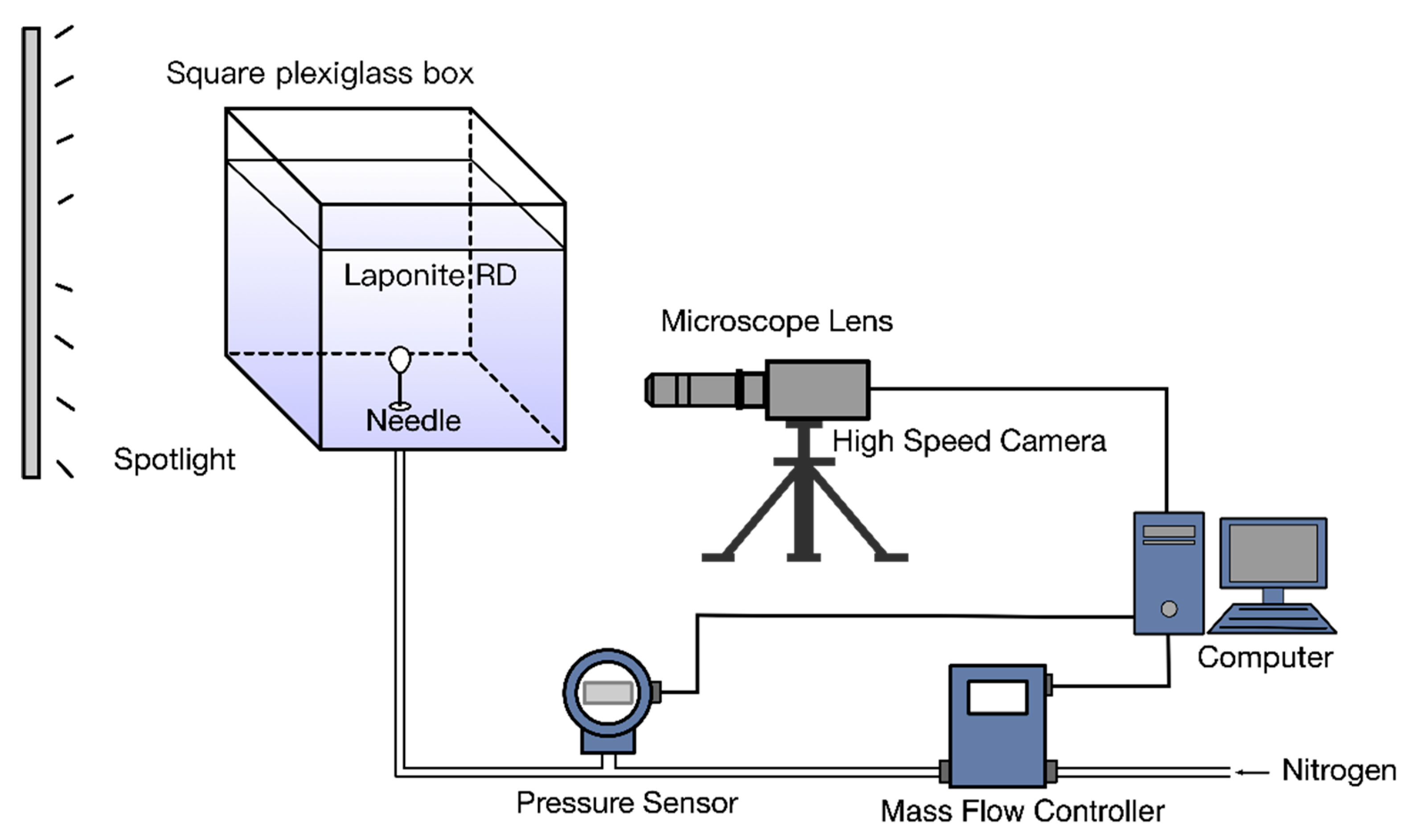
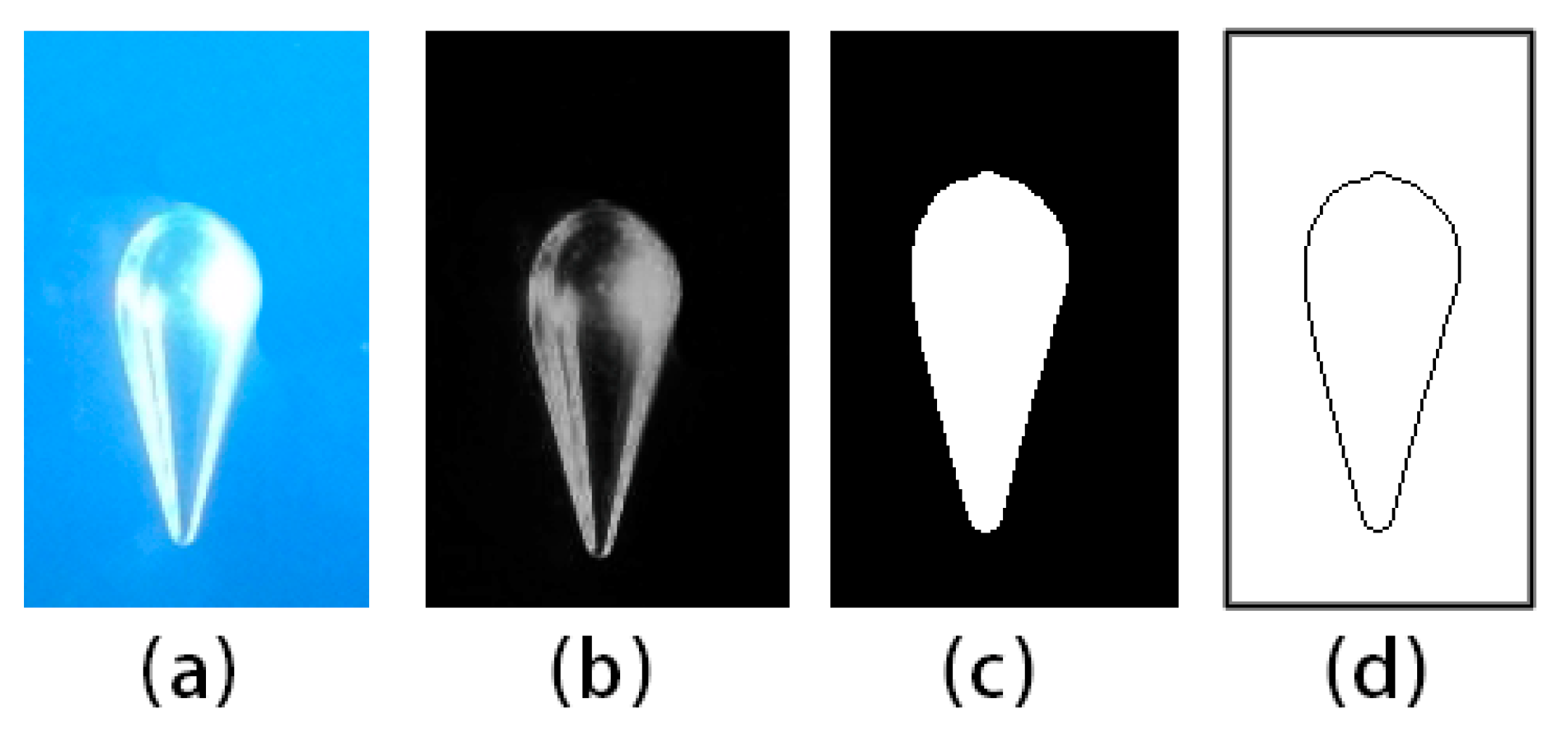


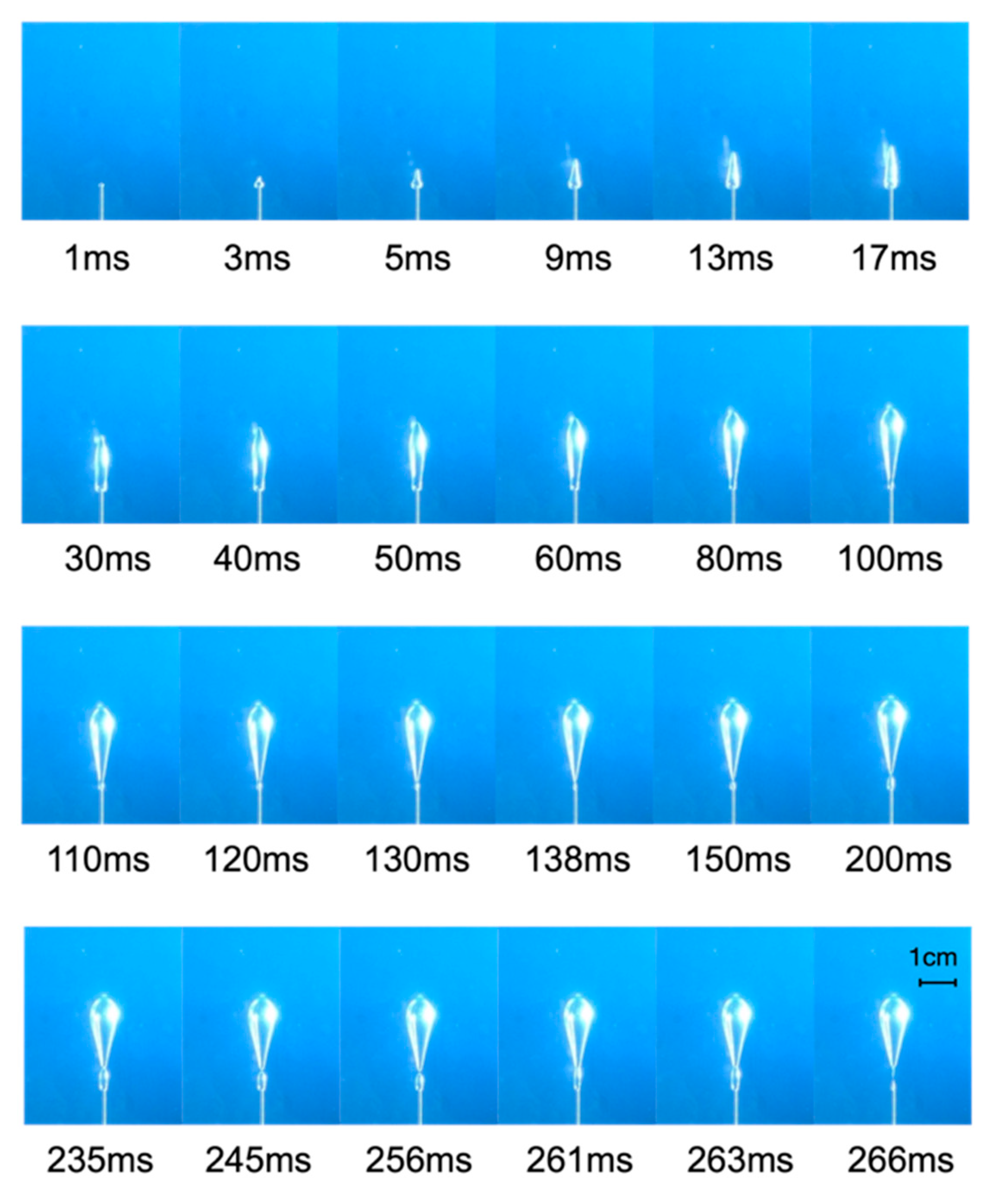
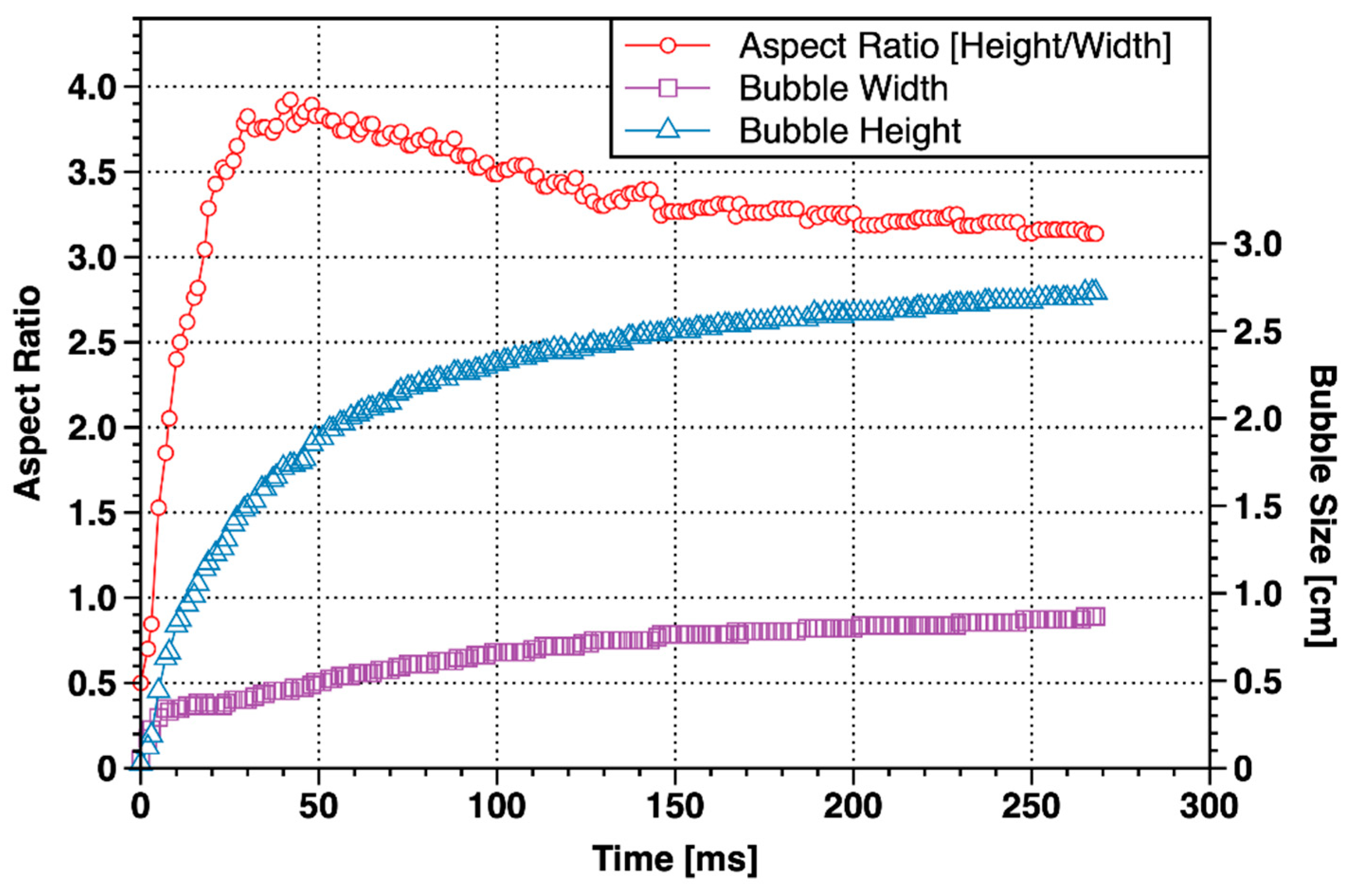


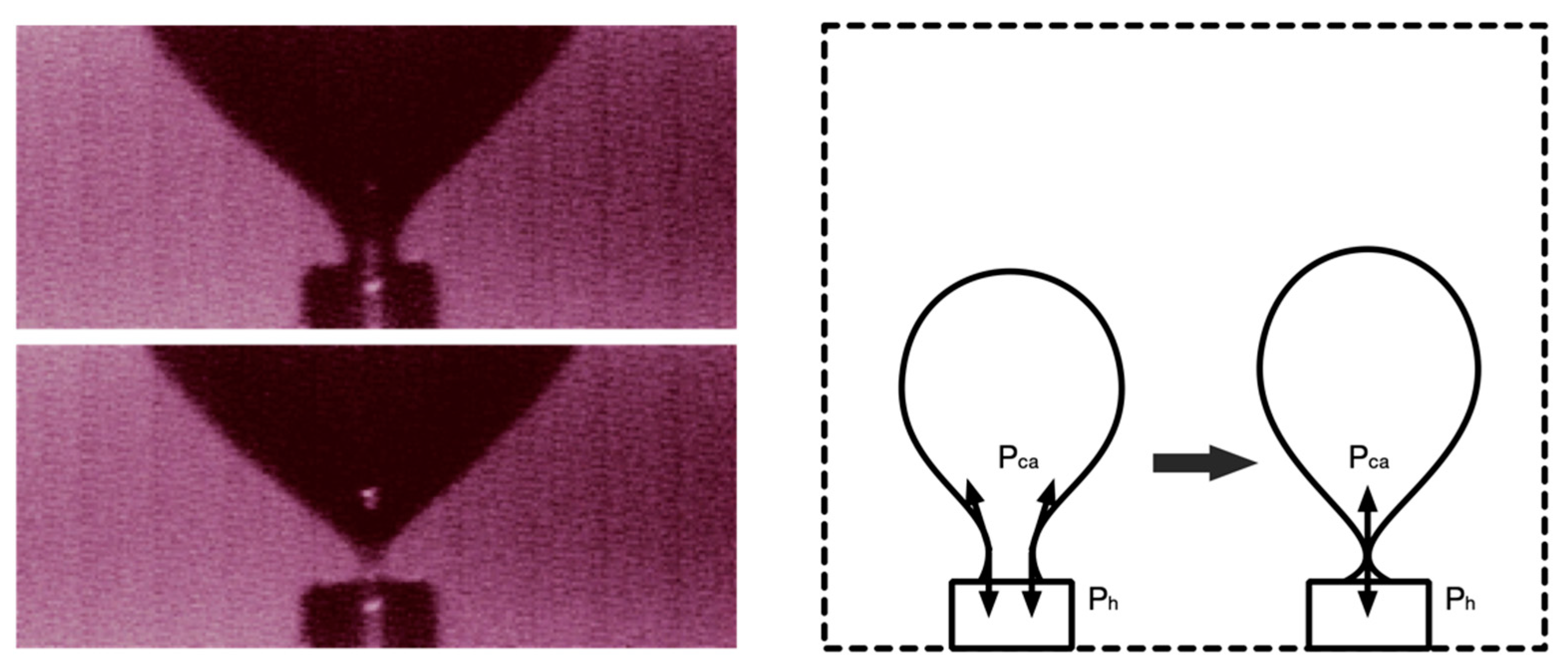
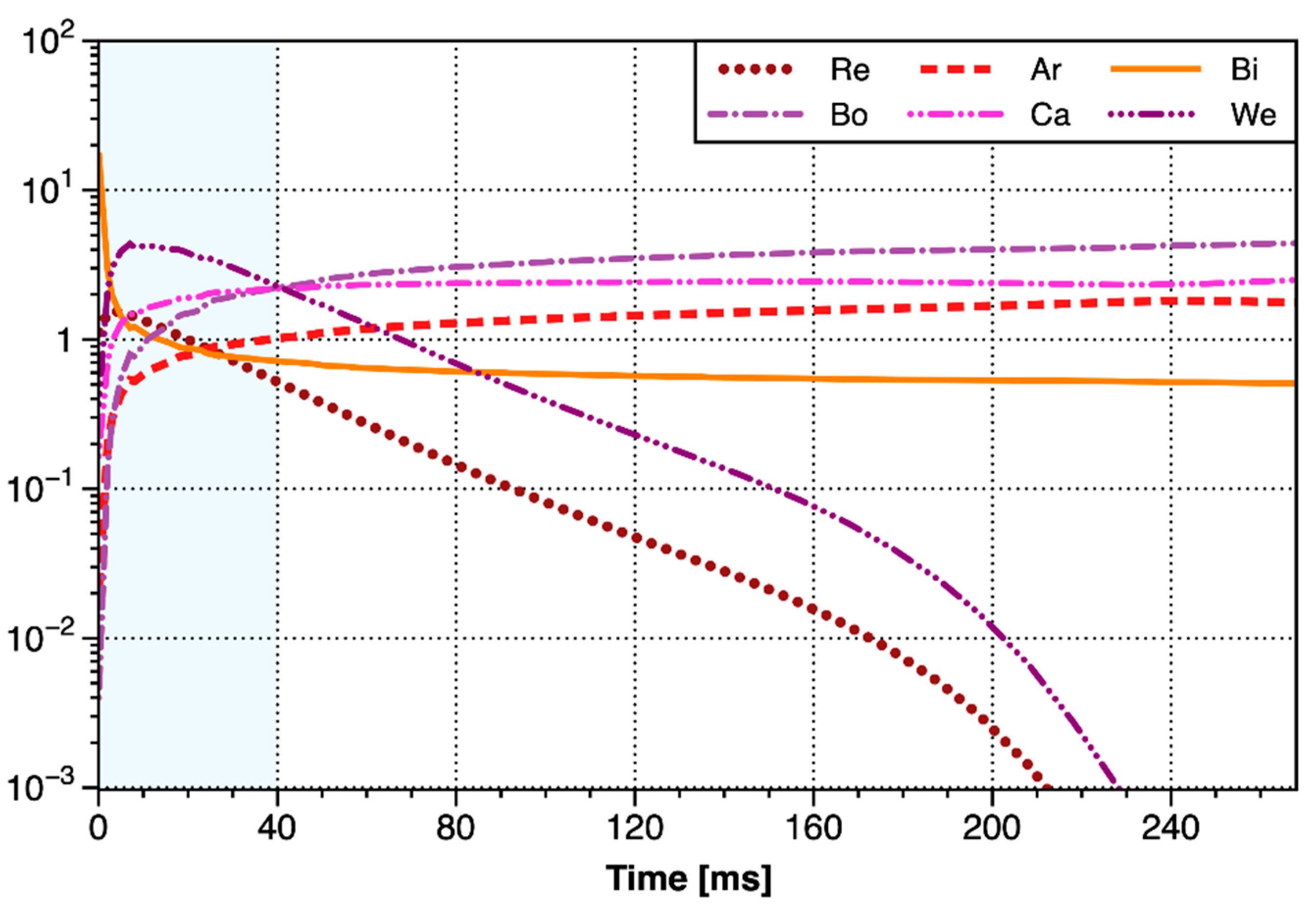
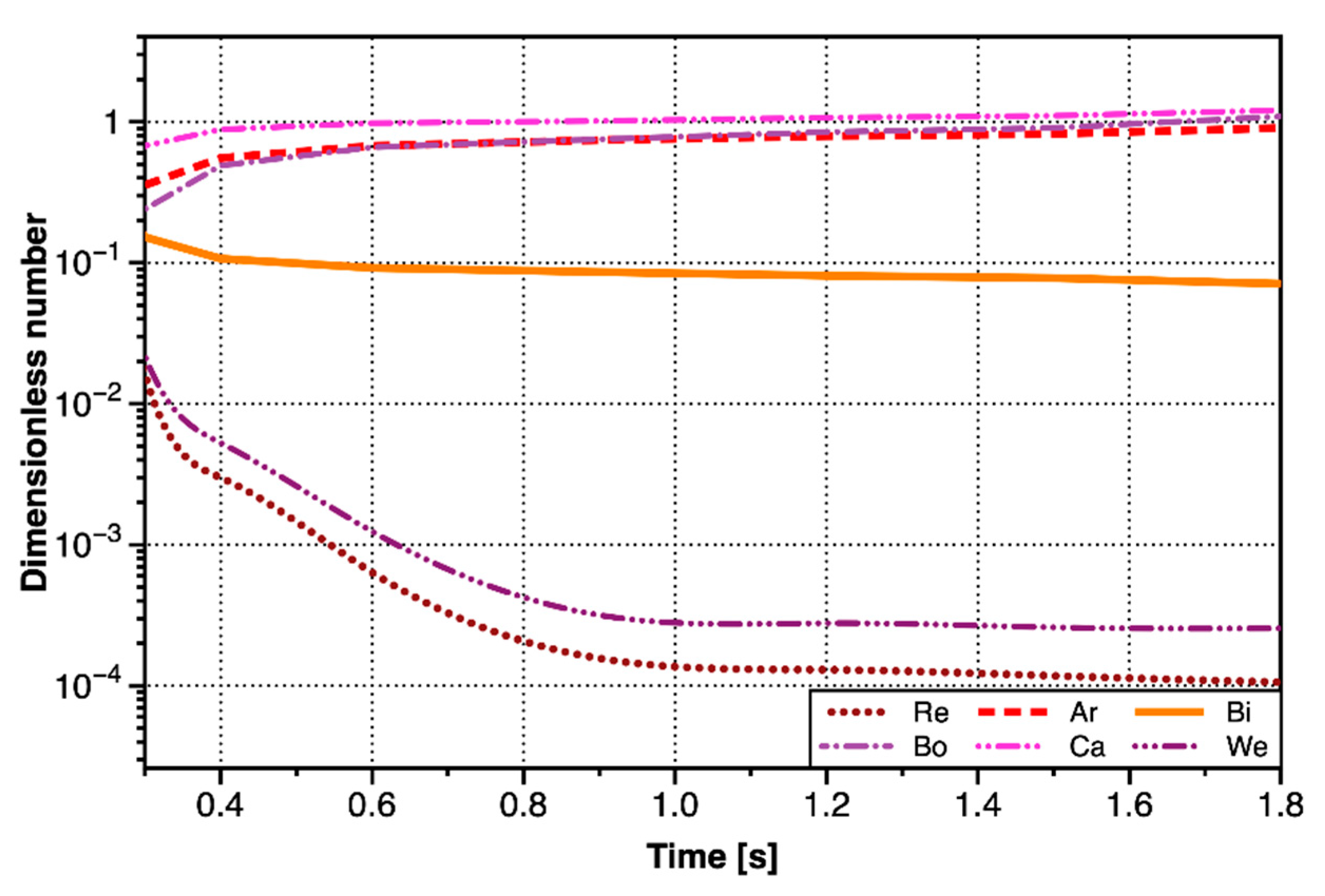


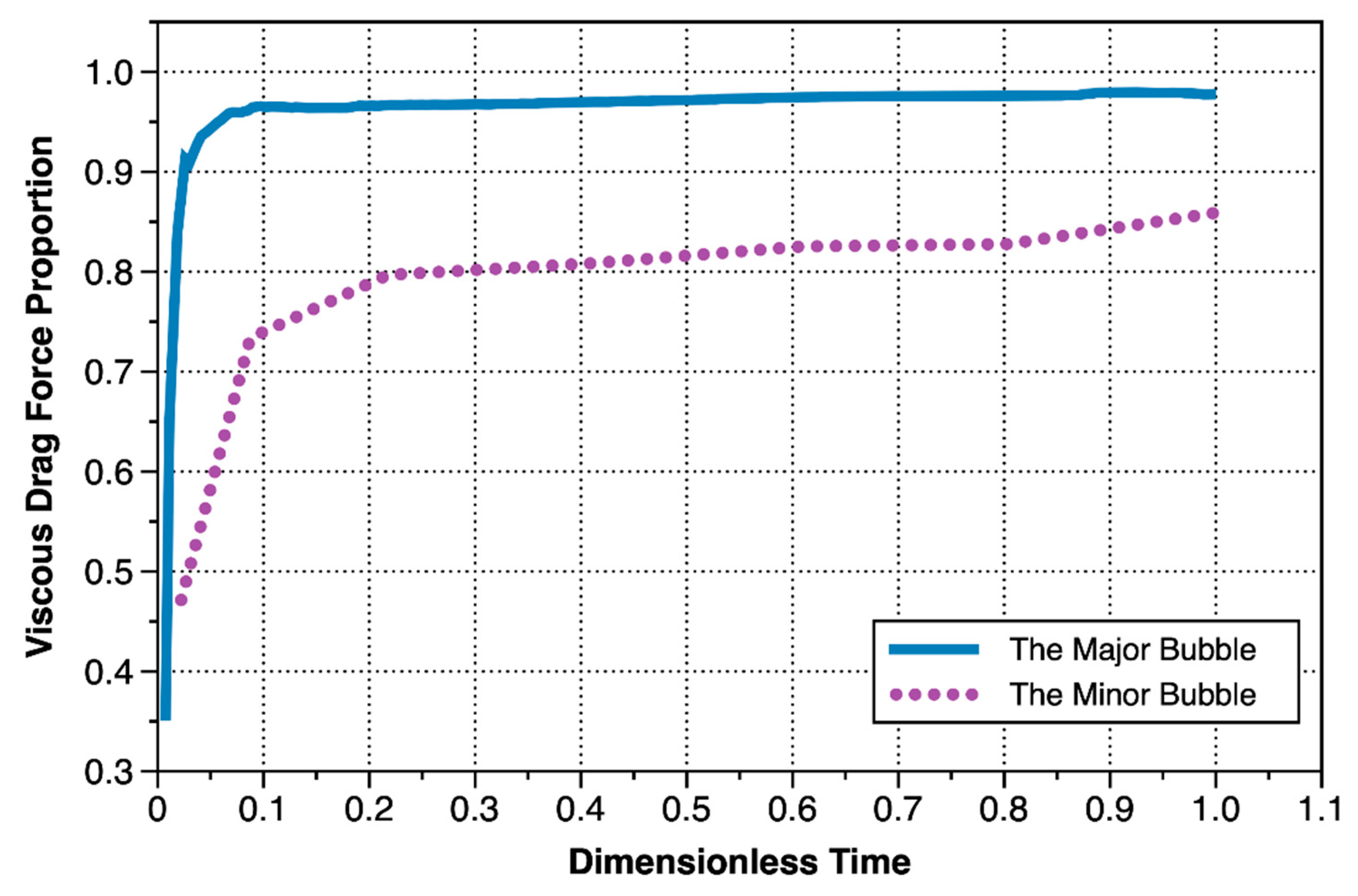
| 28.81 | 2.835 | 0.3744 | 275 | 0.073 | 0.447 | 1020 |
| Symbol | Name | Expression | Meaning |
|---|---|---|---|
| Reynolds number | Ratio of inertial force to viscous force | ||
| Archimedes number | Ratio of buoyancy force to viscous force | ||
| Bingham number | Ratio of yield stress to inertial force | ||
| Bond number | Ratio of buoyancy force to surface tension | ||
| Capillary number | Ratio of viscous force to surface tension | ||
| Weber number | Ratio of inertial force to surface tension |
| Symbol | Name | Expression |
|---|---|---|
| Buoyancy force | ||
| Young–Laplace pressure force | ||
| Gas momentum force | ||
| Inertial force | ||
| Hydrostatic force | ||
| Surface tension force | ||
| Viscous drag force |
© 2020 by the authors. Licensee MDPI, Basel, Switzerland. This article is an open access article distributed under the terms and conditions of the Creative Commons Attribution (CC BY) license (http://creativecommons.org/licenses/by/4.0/).
Share and Cite
Zhang, Y.; Hu, M.; Zhou, Y. An Experimental Study on Bubble Growth in Laponite RD as Thixotropic Yield Material. Materials 2020, 13, 2887. https://doi.org/10.3390/ma13132887
Zhang Y, Hu M, Zhou Y. An Experimental Study on Bubble Growth in Laponite RD as Thixotropic Yield Material. Materials. 2020; 13(13):2887. https://doi.org/10.3390/ma13132887
Chicago/Turabian StyleZhang, Yiping, Mengxian Hu, and Yongchao Zhou. 2020. "An Experimental Study on Bubble Growth in Laponite RD as Thixotropic Yield Material" Materials 13, no. 13: 2887. https://doi.org/10.3390/ma13132887
APA StyleZhang, Y., Hu, M., & Zhou, Y. (2020). An Experimental Study on Bubble Growth in Laponite RD as Thixotropic Yield Material. Materials, 13(13), 2887. https://doi.org/10.3390/ma13132887




